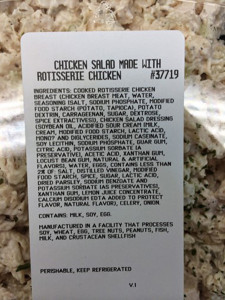Friend of the barfblog.com, Michéle Samarya-Timm, with the Somerset County Department of Health (Jersey, represent) writes:
 While conducting my annual perusal of online Thanksgiving hints, tips, tweets and infographics, I began musing about Thanksgiving post-dinner activities. You know, when folks are leaning back with turkey fatigue, food scraps begin congealing on individual dinner plates, the buffet resembles a feeding frenzy at the zoo, and the kitchen is stacked with pots clogged with unused remnants of fall harvest traditions.
While conducting my annual perusal of online Thanksgiving hints, tips, tweets and infographics, I began musing about Thanksgiving post-dinner activities. You know, when folks are leaning back with turkey fatigue, food scraps begin congealing on individual dinner plates, the buffet resembles a feeding frenzy at the zoo, and the kitchen is stacked with pots clogged with unused remnants of fall harvest traditions.
This mellow and restrained moment often progress into a free-for-all, where guests start jockeying for position to grab leftovers to take back home. This lineup becomes fueled by individual dreams of creating a Friday morning shooter sandwich, turlafel, magical mystery mush or similar creative concoction of post-Thanksgiving residuals. And so, the mad pantry hunt for tin foil, old Tupperware containers or the box of zippy bags begins. You know it will happen. With this in mind, shouldn’t leftover planning be a natural extension of Thanksgiving food prep?
An ideal Thanksgiving schedule allows adequate time for food preparation, thorough cooking and proper cooling of leftovers. Just like asking the family culinary wiz to carve the turkey, the host (or guest) with the most knowledge should be tasked with overseeing the holiday food safety.
Why? You’ve heard the two-hour rule: Never let hot or cold food sit on the dinner table or on the counter for more than 2 hours. After two hours, the food has cooled to the point that it’s in the food danger zone – 40 degrees F to 140 degrees F – the range where bacteria can rapidly reproduce and contaminate the food. This can be a tall task during a holiday meal, but one that is achievable with some creativity.
 Develop a game plan for any extra perishable food. After filling serving dishes in the kitchen, immediately divide up the remaining vittles into smaller portions or pieces, place in shallow containers, and promptly refrigerate. For leftovers tableside, invite guests to pack up what they’d like before the end of that 2-hour window, (try setting a music loop as a timer for that two hours) and encourage folks to stay for more coffee while their take-home bag is chilling in the fridge or freezer before the ride back home. With that, zippy bags full of water make great cheap ice packs for that added touch of food-safety caring to-go.
Develop a game plan for any extra perishable food. After filling serving dishes in the kitchen, immediately divide up the remaining vittles into smaller portions or pieces, place in shallow containers, and promptly refrigerate. For leftovers tableside, invite guests to pack up what they’d like before the end of that 2-hour window, (try setting a music loop as a timer for that two hours) and encourage folks to stay for more coffee while their take-home bag is chilling in the fridge or freezer before the ride back home. With that, zippy bags full of water make great cheap ice packs for that added touch of food-safety caring to-go.
Labeling the food packages makes sense so those who rave about your potatoes with marshmallows don’t find themselves with roasted brussels sprouts. In addition to including recipient names and food contents, labeling containers with safe reheating instructions (to 165 degrees!) ads that little-something extra – and cute, printable tags found online can be adapted for this purpose.
Is that necessary? While folks may be more likely to check the Thanksgiving turkey with a thermometer for doneness (after all, how embarrassing to carve a half-raw bird in front of a table full of salivating guests?), FDA reports that 97% of leftover eaters don’t use a food thermometer before eating to check if the food is safety reheated to prevent possible foodborne illness. You know Aunt Gladys, Uncle Charlie, and your loopy neighbors. Do you want to gamble that these guests are part of the 3% who safely prepare resurrected meals?
Take home meals can take on a life of their own if not properly handled. Reimagining Thanksgiving leftovers takes on a whole new meaning if not eaten over the holiday weekend. After all, the idea isn’t how long the food is pretty or tasty…it’s how long before it can create ill effects. Two storage options exist: Refrigerate and safely eat within 3 to 4 days (that’s Monday), or freeze at 0 degrees F for a longer lasting souvenir.
Enjoy the holiday with your family and friends. And when providing guests with take-home packages of harvest bounty, aim to give them ingredients for post-meal happiness, not a holiday pathogen starter kit.
With much appreciation to all the good folks working to prevent foodborne outbreaks.
 Estee said that he and his employees were “deeply saddened” when they heard that the outbreak was connected to their chocolate mousse, citing that “our first and foremost concern is always the safety of our guests.” He said that they will assist the affected families as they recover.
Estee said that he and his employees were “deeply saddened” when they heard that the outbreak was connected to their chocolate mousse, citing that “our first and foremost concern is always the safety of our guests.” He said that they will assist the affected families as they recover.








